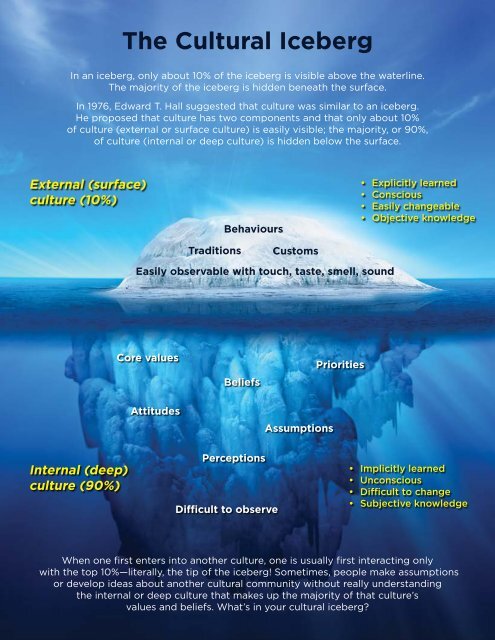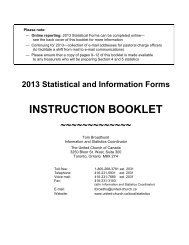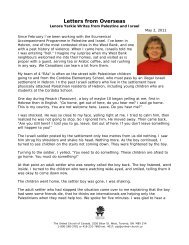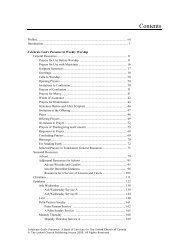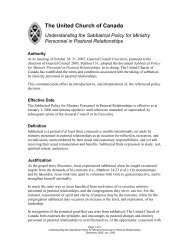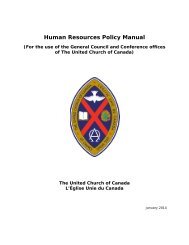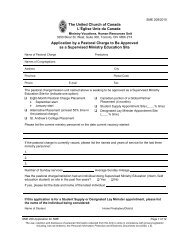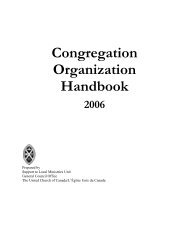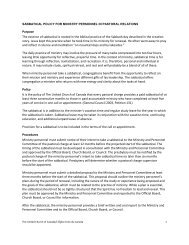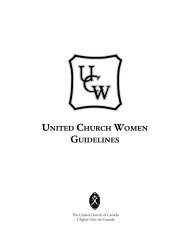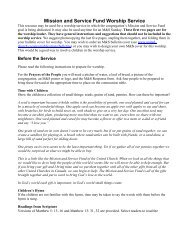The Cultural Iceberg - The United Church of Canada
The Cultural Iceberg - The United Church of Canada
The Cultural Iceberg - The United Church of Canada
You also want an ePaper? Increase the reach of your titles
YUMPU automatically turns print PDFs into web optimized ePapers that Google loves.
<strong>The</strong> <strong>Cultural</strong> <strong>Iceberg</strong><br />
In an iceberg, only about 10% <strong>of</strong> the iceberg is visible above the waterline.<br />
<strong>The</strong> majority <strong>of</strong> the iceberg is hidden beneath the surface.<br />
In 1976, Edward T. Hall suggested that culture was similar to an iceberg.<br />
He proposed that culture has two components and that only about 10%<br />
<strong>of</strong> culture (external or surface culture) is easily visible; the majority, or 90%,<br />
<strong>of</strong> culture (internal or deep culture) is hidden below the surface.<br />
External (surface)<br />
culture (10%)<br />
Behaviours<br />
• Explicitly learned<br />
• Conscious<br />
• Easily changeable<br />
• Objective knowledge<br />
Traditions<br />
Customs<br />
Easily observable with touch, taste, smell, sound<br />
Core values<br />
Beliefs<br />
Priorities<br />
Attitudes<br />
Assumptions<br />
Internal (deep)<br />
culture (90%)<br />
Perceptions<br />
Difficult to observe<br />
• Implicitly learned<br />
• Unconscious<br />
• Difficult to change<br />
• Subjective knowledge<br />
When one first enters into another culture, one is usually first interacting only<br />
with the top 10%—literally, the tip <strong>of</strong> the iceberg! Sometimes, people make assumptions<br />
or develop ideas about another cultural community without really understanding<br />
the internal or deep culture that makes up the majority <strong>of</strong> that culture’s<br />
values and beliefs. What’s in your cultural iceberg?
<strong>The</strong> <strong>Cultural</strong> <strong>Iceberg</strong><br />
art<br />
food<br />
dress/clothing<br />
greetings<br />
dance<br />
language<br />
music<br />
Top 10%<br />
world view<br />
gender roles<br />
personal space<br />
authority<br />
concepts <strong>of</strong> justice<br />
ideas about modesty<br />
cooperation /<br />
competitiveness<br />
religious beliefs<br />
ideas about leadership<br />
body language<br />
designation <strong>of</strong> status<br />
based on positions (e.g.,<br />
age, gender, job)<br />
concepts <strong>of</strong> time<br />
friendship<br />
notions <strong>of</strong><br />
child-rearing<br />
(and how children<br />
behave in church)<br />
decision-making models<br />
communication<br />
definition <strong>of</strong> sin<br />
pace <strong>of</strong> work<br />
dating and courtship practices<br />
power<br />
Bottom 90%


